2016 DODGE VIPER warning
[x] Cancel search: warningPage 54 of 423

The Occupant Classification System (OCS) consists of
the following:
•Occupant Restraint Controller (ORC)
• Occupant Classification Module (OCM) and Sensor
located in the front passenger seat
• Passenger Air Bag Disabled (PAD) Indicator Light – an
amber light located in the center of the instrument
panel (show icon)
• Air Bag Warning Light
Occupant Classification Module (OCM) And Sensor
The Occupant Classification Module (OCM) is located
underneath the front passenger seat. The Sensor is lo-
cated beneath the passenger seat cushion foam. Any
weight on the seat will be sensed by the Sensor. The OCM uses input from the Sensor to determine the front pas-
senger ’s most probable classification. The OCM commu-
nicates this information to the ORC. The ORC uses the
classification to determine whether it should activate or
deactivate the Passenger Advanced Front Air Bag. In
order for the OCS to operate as designed, it is important
for the front passenger to be seated properly and prop-
erly wearing the seat belt. Properly seated passengers are:
•
Sitting upright
• Facing forward
• Sitting in the center of the seat with their feet comfort-
ably on or near the floor.
52 THINGS TO KNOW BEFORE STARTING YOUR VEHICLE
Page 57 of 423
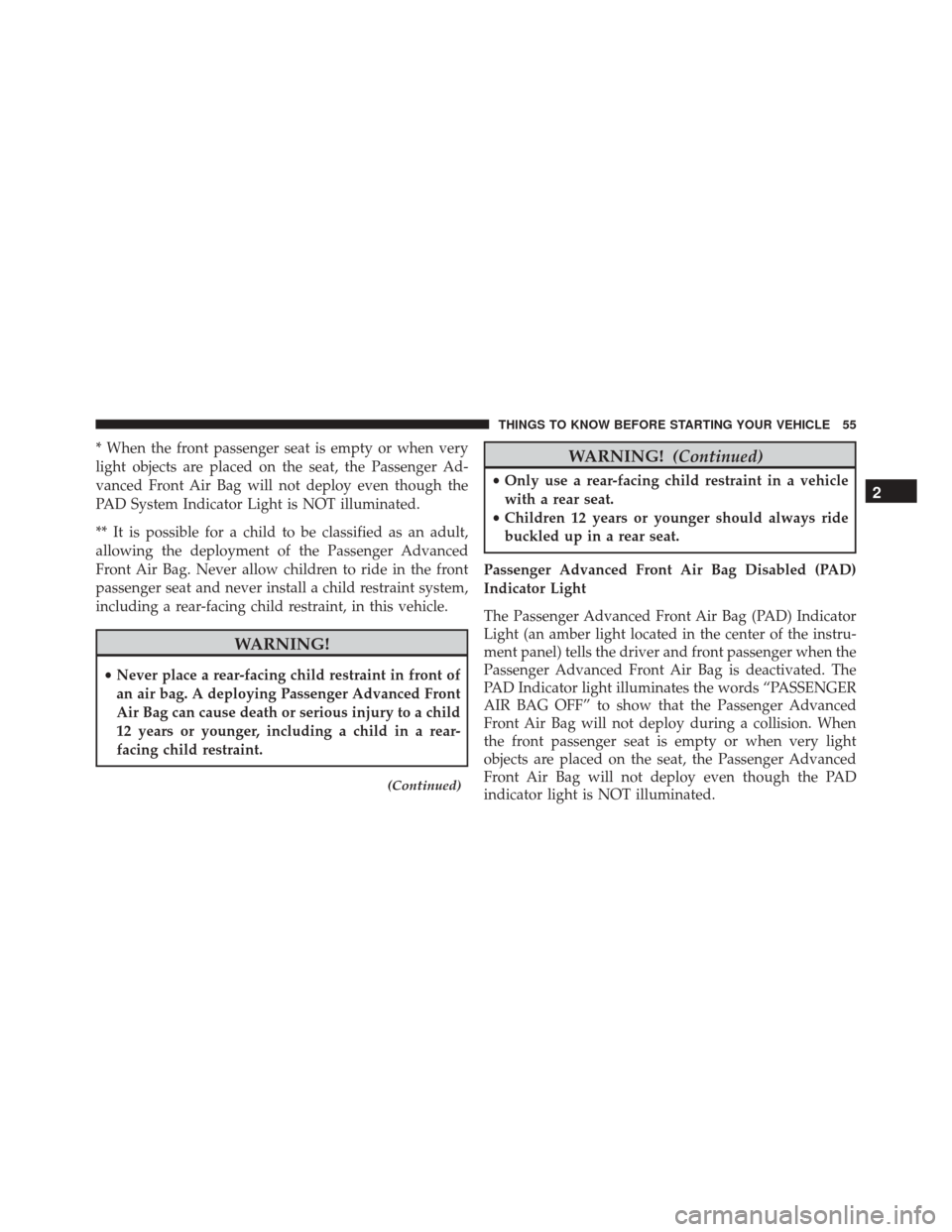
* When the front passenger seat is empty or when very
light objects are placed on the seat, the Passenger Ad-
vanced Front Air Bag will not deploy even though the
PAD System Indicator Light is NOT illuminated.
** It is possible for a child to be classified as an adult,
allowing the deployment of the Passenger Advanced
Front Air Bag. Never allow children to ride in the front
passenger seat and never install a child restraint system,
including a rear-facing child restraint, in this vehicle.
WARNING!
•Never place a rear-facing child restraint in front of
an air bag. A deploying Passenger Advanced Front
Air Bag can cause death or serious injury to a child
12 years or younger, including a child in a rear-
facing child restraint.
(Continued)
WARNING! (Continued)
•Only use a rear-facing child restraint in a vehicle
with a rear seat.
• Children 12 years or younger should always ride
buckled up in a rear seat.
Passenger Advanced Front Air Bag Disabled (PAD)
Indicator Light
The Passenger Advanced Front Air Bag (PAD) Indicator
Light (an amber light located in the center of the instru-
ment panel) tells the driver and front passenger when the
Passenger Advanced Front Air Bag is deactivated. The
PAD Indicator light illuminates the words “PASSENGER
AIR BAG OFF” to show that the Passenger Advanced
Front Air Bag will not deploy during a collision. When
the front passenger seat is empty or when very light
objects are placed on the seat, the Passenger Advanced
Front Air Bag will not deploy even though the PAD
indicator light is NOT illuminated.2
THINGS TO KNOW BEFORE STARTING YOUR VEHICLE 55
Page 59 of 423

4. Have the adult passenger sit in the center of the seat,with the passenger ’s feet comfortably on or near the
floor, and with their back against the seatback.
5. Restart the vehicle and have the passenger remain in this seated position for two to three minutes after
restarting the vehicle.
WARNING!
If the PAD Indicator Light remains illuminated for
an adult passenger, have an authorized dealer service
the air bag system immediately. Failure to do so may
cause serious injury or death. If the PAD Indicator
Light is illuminated with the words “PASSENGER
AIR BAG OFF” the Passenger Advanced Front Air
Bag will not inflate in the event of a collision.
WARNING!
•Never place a rear-facing child restraint in front of
an air bag. A deploying Passenger Advanced Front
Air Bag can cause death or serious injury to a child
12 years or younger, including a child in a rear-
facing child restraint.
• Only use a rear-facing child restraint in a vehicle
with a rear seat.
• Children 12 years or younger should always ride
buckled up in a rear seat.
Lighter Weight Passengers (Including Small Adults)
When a lighter weight passenger, including a small adult
occupies the passenger seat, the Passenger Advanced
Front Air Bag may be deactivated. Therefore, the Passen-
ger Advanced Front Air Bag may or may not be activated
for a lighter weight passenger, including a small adult2
THINGS TO KNOW BEFORE STARTING YOUR VEHICLE 57
Page 63 of 423
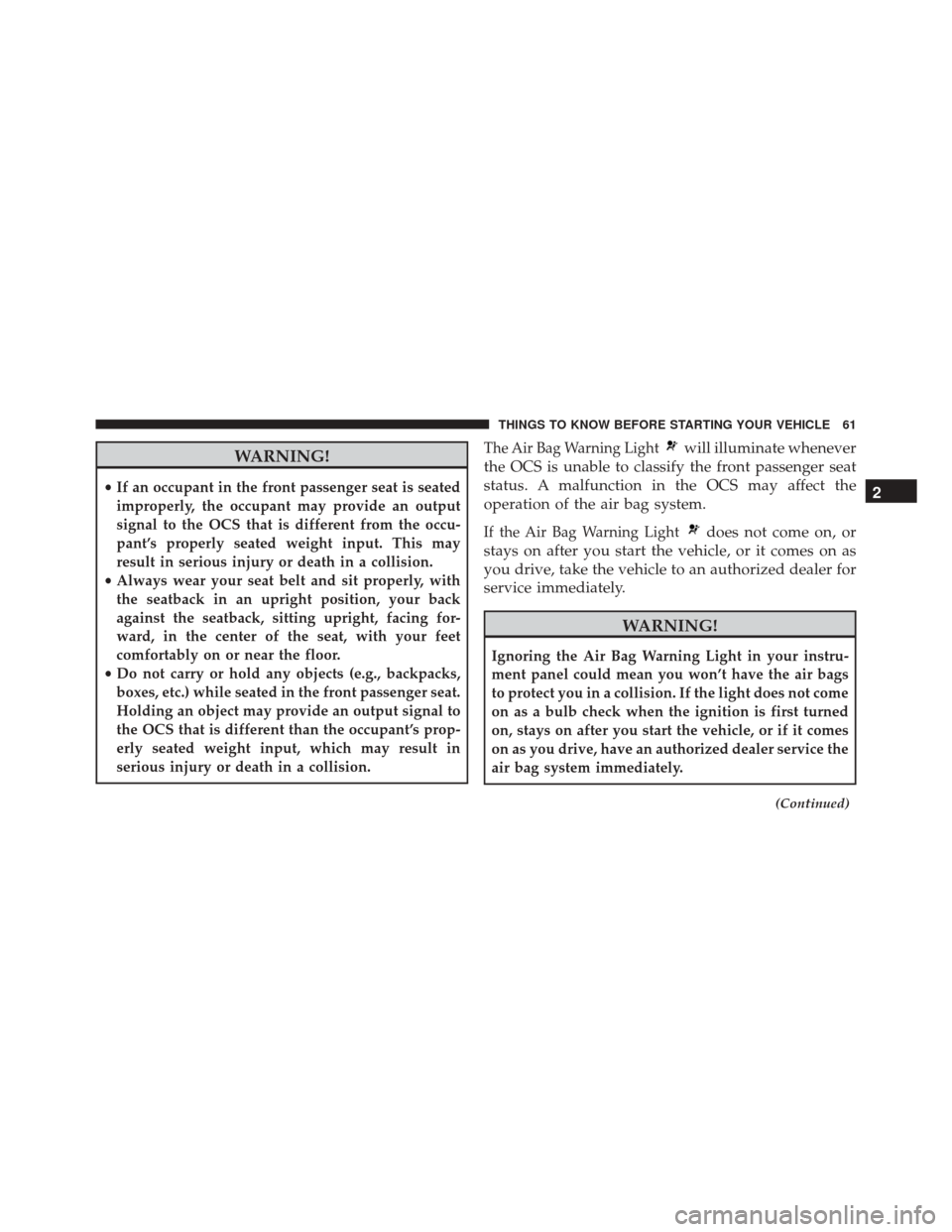
WARNING!
•If an occupant in the front passenger seat is seated
improperly, the occupant may provide an output
signal to the OCS that is different from the occu-
pant’s properly seated weight input. This may
result in serious injury or death in a collision.
• Always wear your seat belt and sit properly, with
the seatback in an upright position, your back
against the seatback, sitting upright, facing for-
ward, in the center of the seat, with your feet
comfortably on or near the floor.
• Do not carry or hold any objects (e.g., backpacks,
boxes, etc.) while seated in the front passenger seat.
Holding an object may provide an output signal to
the OCS that is different than the occupant’s prop-
erly seated weight input, which may result in
serious injury or death in a collision. The Air Bag Warning Light
will illuminate whenever
the OCS is unable to classify the front passenger seat
status. A malfunction in the OCS may affect the
operation of the air bag system.
If the Air Bag Warning Lightdoes not come on, or
stays on after you start the vehicle, or it comes on as
you drive, take the vehicle to an authorized dealer for
service immediately.
WARNING!
Ignoring the Air Bag Warning Light in your instru-
ment panel could mean you won’t have the air bags
to protect you in a collision. If the light does not come
on as a bulb check when the ignition is first turned
on, stays on after you start the vehicle, or if it comes
on as you drive, have an authorized dealer service the
air bag system immediately.
(Continued)
2
THINGS TO KNOW BEFORE STARTING YOUR VEHICLE 61
Page 64 of 423

WARNING!(Continued)
Placing an object on the floor under the front pas-
senger seat may prevent the OCS from working
properly, which may result in serious injury or death
in a collision. Do not place any objects on the floor
under the front passenger seat.
If there is a fault present in the OCS, both the PAD
Indicator Light and the Air Bag Warning Light will
illuminate to show that the Passenger Advanced
Front Air Bag is deactivated. Should this occur, the
Passenger Advanced Front Air Bag will remain deac-
tivated until the fault is cleared. This indicates that
you should take the vehicle to an authorized dealer
for service immediately.
The passenger seat assembly contains critical OCS com-
ponents that may affect Passenger Advanced Front Air
Bag inflation. In order for the OCS to properly classify the seated weight of a front seat passenger, the OCS compo-
nents must function as designed. Do not make any
modifications to the front passenger seat components,
assembly, or to the seat cover. If the seat, trim cover, or
cushion needs service for any reason, take the vehicle to
your authorized dealer. Only FCA US LLC approved seat
accessories may be used.
The following requirements must be strictly followed:
•
Do not modify the front passenger seat assembly or
components in any way.
• Do not use prior or future model year seat covers or
cushions not designated by FCA US LLC for the
specific model being repaired. Always use the correct
seat cover and cushion specified for the vehicle.
• Do not replace the seat cover or cushion with an
aftermarket seat cover or cushion.
• Do not add a secondary seat cover or mat.
62 THINGS TO KNOW BEFORE STARTING YOUR VEHICLE
Page 65 of 423
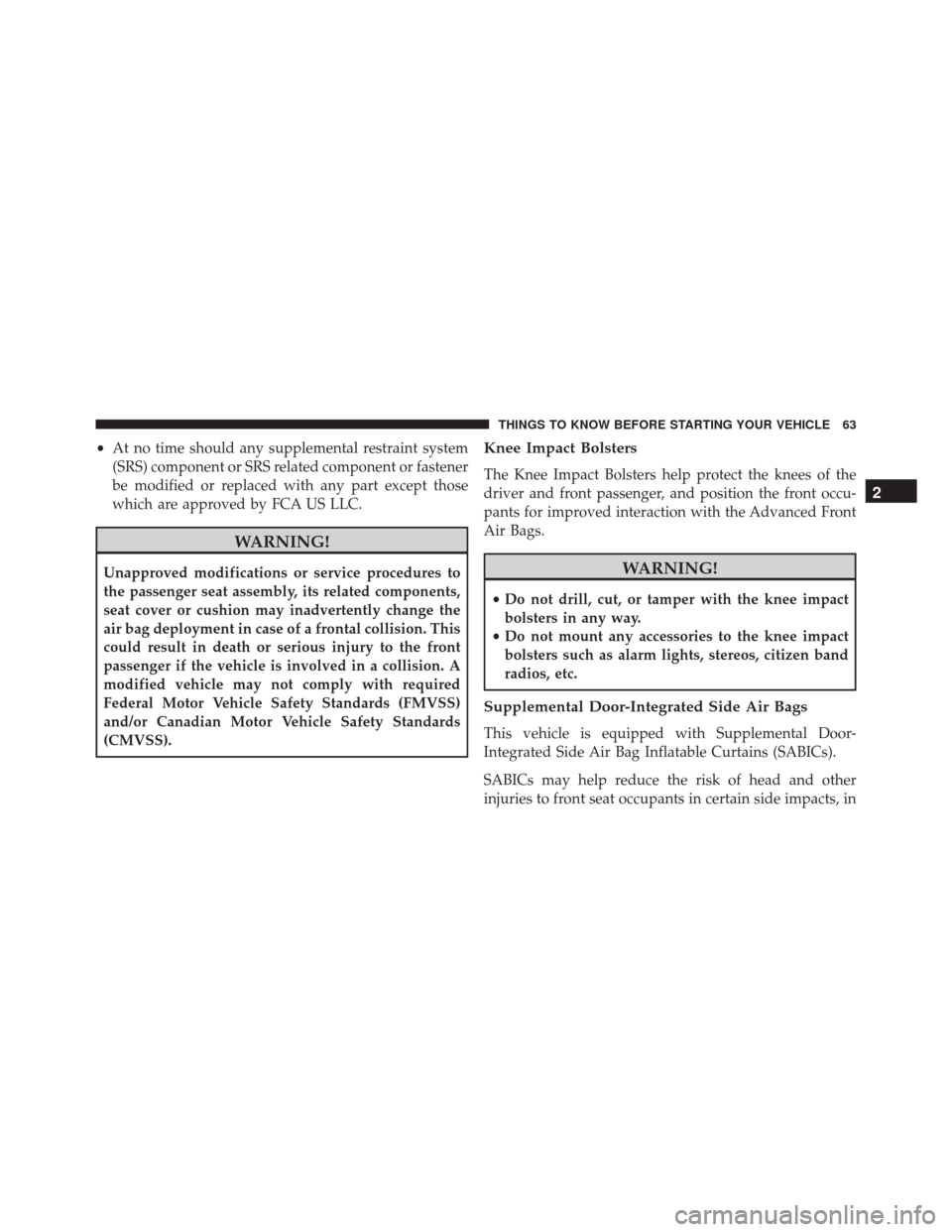
•At no time should any supplemental restraint system
(SRS) component or SRS related component or fastener
be modified or replaced with any part except those
which are approved by FCA US LLC.
WARNING!
Unapproved modifications or service procedures to
the passenger seat assembly, its related components,
seat cover or cushion may inadvertently change the
air bag deployment in case of a frontal collision. This
could result in death or serious injury to the front
passenger if the vehicle is involved in a collision. A
modified vehicle may not comply with required
Federal Motor Vehicle Safety Standards (FMVSS)
and/or Canadian Motor Vehicle Safety Standards
(CMVSS).
Knee Impact Bolsters
The Knee Impact Bolsters help protect the knees of the
driver and front passenger, and position the front occu-
pants for improved interaction with the Advanced Front
Air Bags.
WARNING!
• Do not drill, cut, or tamper with the knee impact
bolsters in any way.
• Do not mount any accessories to the knee impact
bolsters such as alarm lights, stereos, citizen band
radios, etc.
Supplemental Door-Integrated Side Air Bags
This vehicle is equipped with Supplemental Door-
Integrated Side Air Bag Inflatable Curtains (SABICs).
SABICs may help reduce the risk of head and other
injuries to front seat occupants in certain side impacts, in
2
THINGS TO KNOW BEFORE STARTING YOUR VEHICLE 63
Page 67 of 423
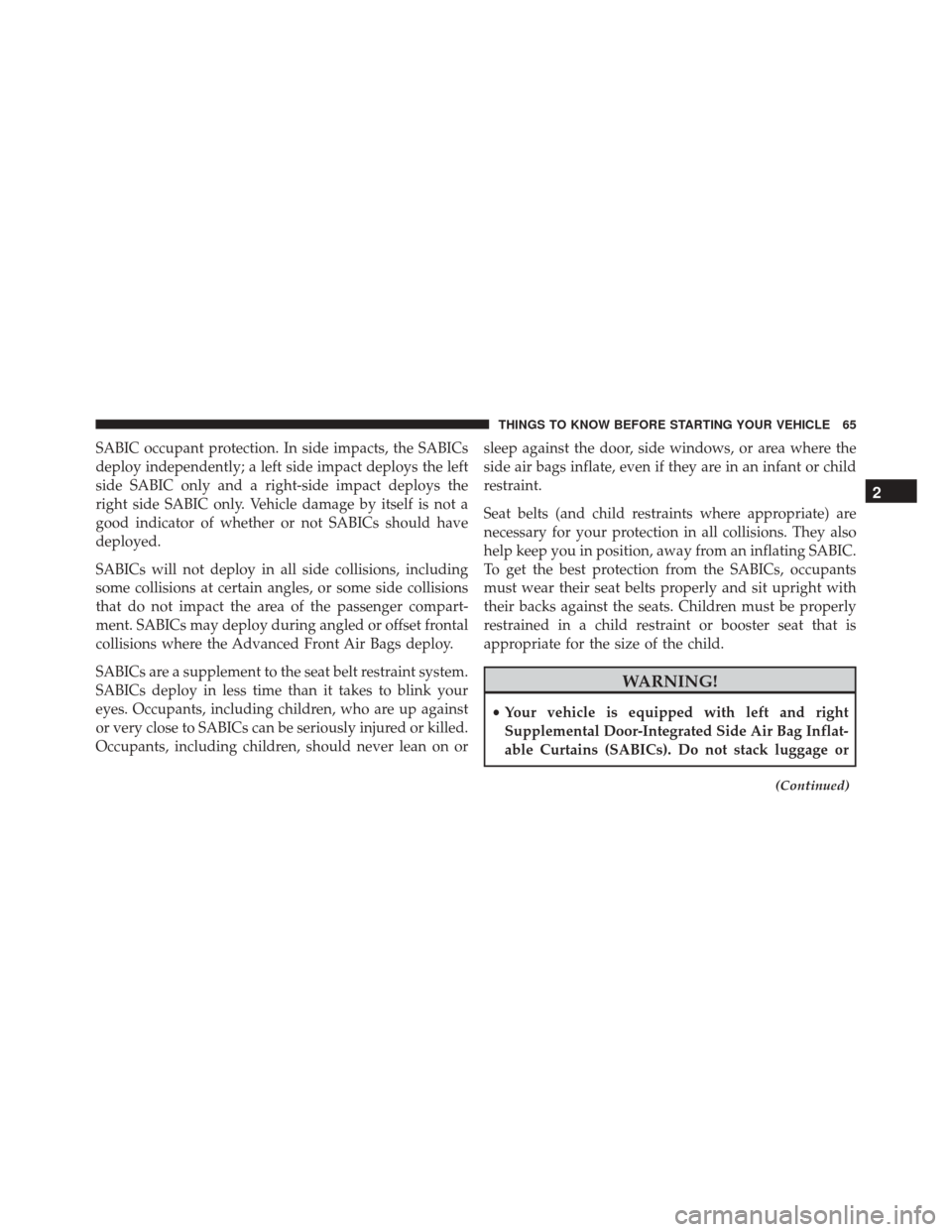
SABIC occupant protection. In side impacts, the SABICs
deploy independently; a left side impact deploys the left
side SABIC only and a right-side impact deploys the
right side SABIC only. Vehicle damage by itself is not a
good indicator of whether or not SABICs should have
deployed.
SABICs will not deploy in all side collisions, including
some collisions at certain angles, or some side collisions
that do not impact the area of the passenger compart-
ment. SABICs may deploy during angled or offset frontal
collisions where the Advanced Front Air Bags deploy.
SABICs are a supplement to the seat belt restraint system.
SABICs deploy in less time than it takes to blink your
eyes. Occupants, including children, who are up against
or very close to SABICs can be seriously injured or killed.
Occupants, including children, should never lean on orsleep against the door, side windows, or area where the
side air bags inflate, even if they are in an infant or child
restraint.
Seat belts (and child restraints where appropriate) are
necessary for your protection in all collisions. They also
help keep you in position, away from an inflating SABIC.
To get the best protection from the SABICs, occupants
must wear their seat belts properly and sit upright with
their backs against the seats. Children must be properly
restrained in a child restraint or booster seat that is
appropriate for the size of the child.
WARNING!
•
Your vehicle is equipped with left and right
Supplemental Door-Integrated Side Air Bag Inflat-
able Curtains (SABICs). Do not stack luggage or
(Continued)
2
THINGS TO KNOW BEFORE STARTING YOUR VEHICLE 65
Page 68 of 423
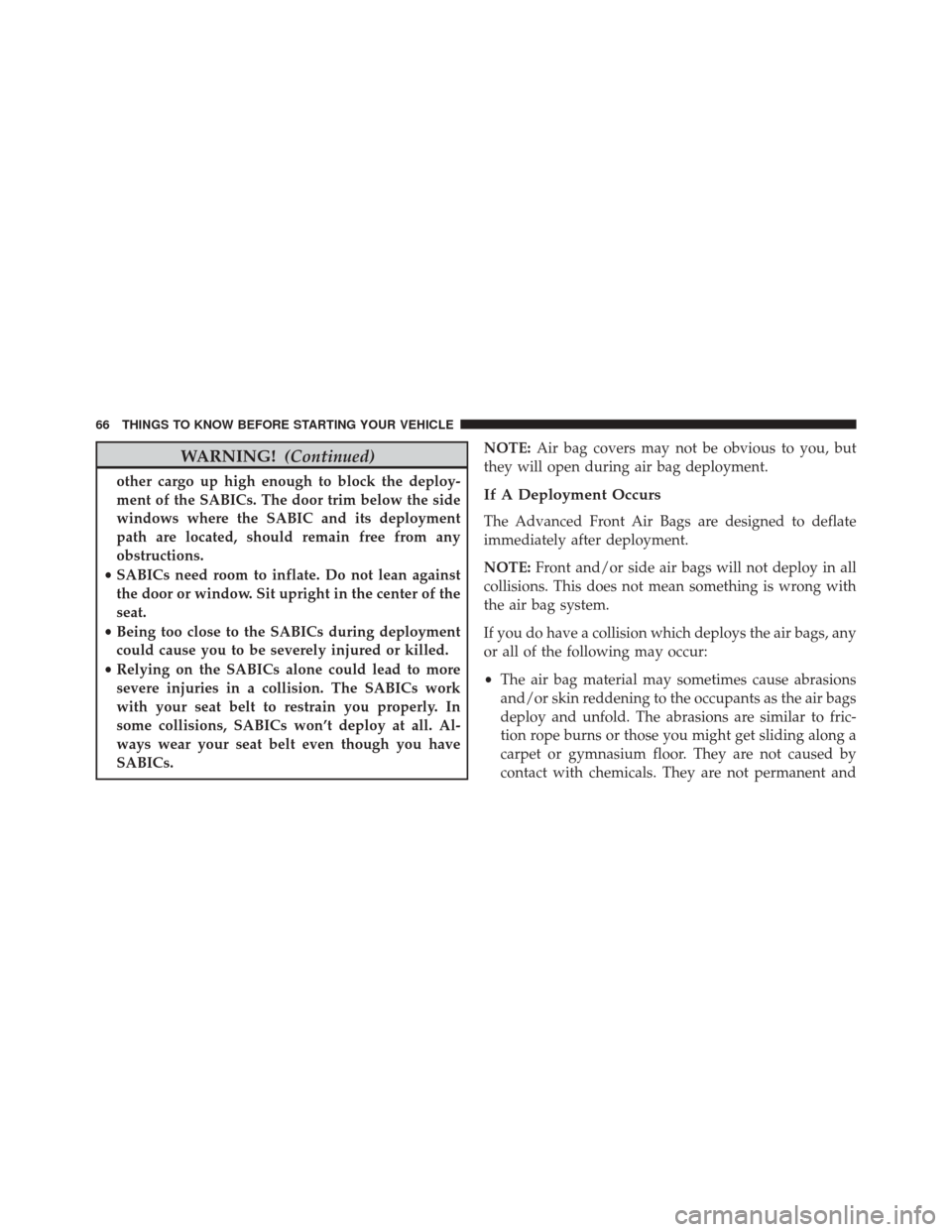
WARNING!(Continued)
other cargo up high enough to block the deploy-
ment of the SABICs. The door trim below the side
windows where the SABIC and its deployment
path are located, should remain free from any
obstructions.
• SABICs need room to inflate. Do not lean against
the door or window. Sit upright in the center of the
seat.
• Being too close to the SABICs during deployment
could cause you to be severely injured or killed.
• Relying on the SABICs alone could lead to more
severe injuries in a collision. The SABICs work
with your seat belt to restrain you properly. In
some collisions, SABICs won’t deploy at all. Al-
ways wear your seat belt even though you have
SABICs. NOTE:
Air bag covers may not be obvious to you, but
they will open during air bag deployment.If A Deployment Occurs
The Advanced Front Air Bags are designed to deflate
immediately after deployment.
NOTE: Front and/or side air bags will not deploy in all
collisions. This does not mean something is wrong with
the air bag system.
If you do have a collision which deploys the air bags, any
or all of the following may occur:
• The air bag material may sometimes cause abrasions
and/or skin reddening to the occupants as the air bags
deploy and unfold. The abrasions are similar to fric-
tion rope burns or those you might get sliding along a
carpet or gymnasium floor. They are not caused by
contact with chemicals. They are not permanent and
66 THINGS TO KNOW BEFORE STARTING YOUR VEHICLE